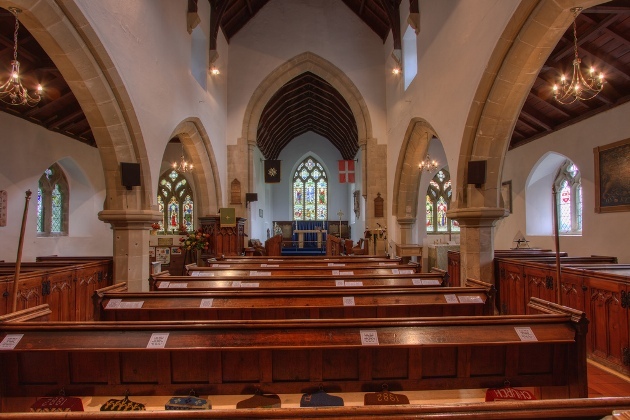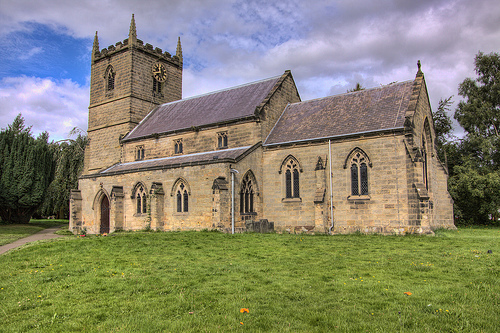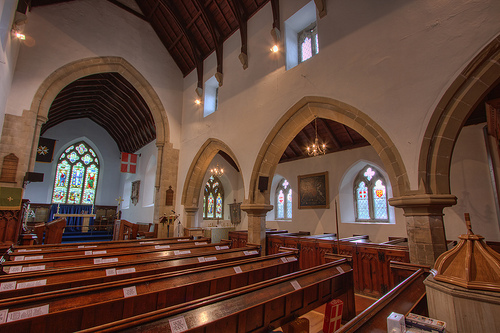
Heather nave
Some 13 miles north-west of Leicester lies the small village of Heather (pronounced ‘Heether’). Its nearest larger neighbour Ibstock is a couple of miles to the south-east. In the Domesday book of 1086 the village is called Hadre meaning the heathlands. It has seen coal mining and brick works in its past and is situated next to the Sence Valley Country Park which was home to a large open cast coal mine which removed 8 million tonnes of coal. It has now been landscaped with a lake, trees and open land with plenty of walks.

South view of Heather church the clock was re-gilded in 2009
The church of St John the Baptist is of the English Decorated style which dates between 1275 and 1380. The earliest parts of the church are the nave and south aisle which date from this period. The clerestory windows were added in the 15th century as well as the tower. The church consists of a west tower, nave, north & south aisles and chancel. In 1846-47 the church underwent restoration by a H. I. Stevens of Derby, the chancel was rebuilt, the north aisle added (in Decorated style) and a short recessed spire removed. There is a piscina in the south aisle and in the chancel a monument to a Stephen Everard (died 1615) who is represented with his wife and seven children in the attitude of prayer.

South aisle and the clerestory windows in nave
In 1885 the chancel was decorated at the cost of the rector, a remarkable beautiful stained glass window by Burlison and Grylls was inserted to the memory of three previous rectors. The font probably dates from the Victorian period although the base may be older. At the west end of the church is a fine organ gallery, this was erected as a memorial to those who lost their lives during the two World Wars. The clock has recently been re-gilded and there was scaffolding around the tower a week before my arrival.

West organ gallery built as a War memorial
Although Heather does not have great monuments or outstanding architecture the church of St John the Baptist at Heather is very pleasant. With its whitewashed walls and windows it is an attractive church. There is parking on the road outside and there are amenities in the village.
![]()



November 18, 2020
My great grandfather Herbert Standidge was Rector there for 49 years and his wife Mary (May) Raised the money for the porch. Both Herbert and Mary along with his mother Isabella Maria and buried there. Herbert and Mary lived in the Manor House with their daughters Ida Mary and my grandmother Kathleen May. Herbert and Mary also had 3 sons who died within a few weeks of being born. At one time there was a path from the church to the Manor House and two of the sons, Eric and Frank were buried by the gate, sadly their gravestones no longer exist. From what I have been told, Herbert was of an austere character while his wife was the opposite, 2 stories that have been passed down were 1) Herbert was immediately accepted as “ one of us” when he was seen carrying his cricket bat from the removal vehicle to the house. 2) a young lady who was shunned by the congregation as she was unmarried and pregnant, and Herbert reminded them of a bible reading (John, chapter 8, V7) “let him who is without sin, cast the first stone”. My Grandmother died in 2002 and her wishes were that her ashes be buried within the grounds of her former childhood home. The owners at the time were kind enough to allow that to happen.
I hope someone may find this very small bit of history of interest
August 14, 2022
Thankyou for your family history.i am from Barwell,last week was my aunts funeral , she was 93 the last of my mums siblings.the service was in our parish church of St Mary’s . I love family stories of our county . My family all grew up under our church’s umbrella and the seasonal activities.it was a happy and simple life .